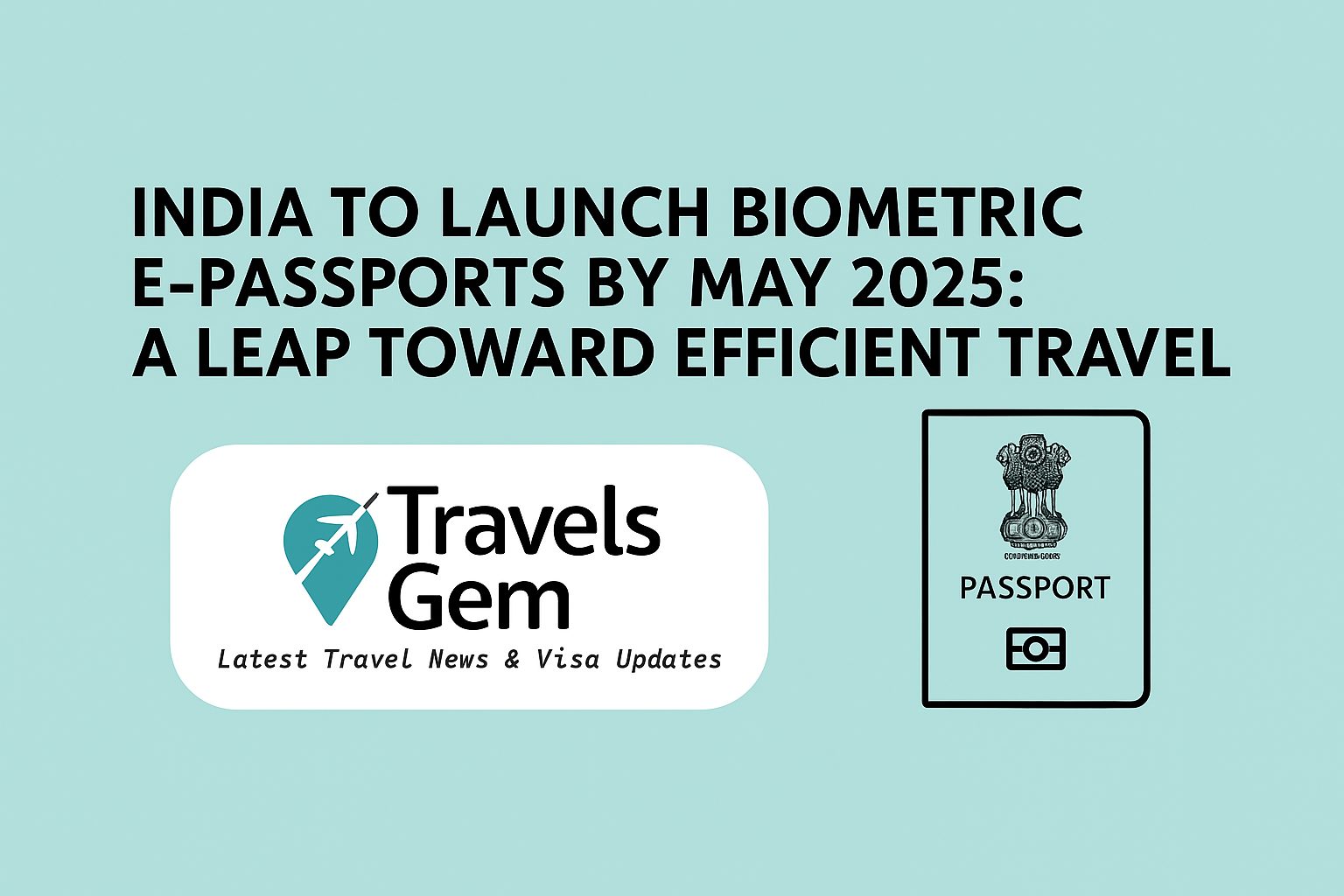In a transformative move to modernize travel documentation and enhance national security, India is set to roll out biometric e-passports nationwide starting May 2025. This initiative, spearheaded by the Ministry of External Affairs (MEA) in collaboration with the India Security Press (ISP) in Nashik, marks a significant step in aligning India’s passport system with global standards. The introduction of chip-enabled e-passports, equipped with advanced biometric features and robust encryption, promises to streamline immigration processes, bolster security, and elevate the travel experience for millions of Indian citizens. This article delves into the details of India’s e-passport program, its features, benefits, implementation strategy, and implications for travelers and the global travel ecosystem.
What Are Biometric E-Passports?
Biometric e-passports, also known as electronic passports, are advanced travel documents embedded with a microprocessor chip that securely stores the passport holder’s personal and biometric data. Unlike traditional passports, which rely solely on printed information, e-passports integrate digital technology to enhance security and efficiency. The chip, typically embedded in the back cover of the passport booklet, contains:
- Personal Information: Name, date of birth, nationality, passport number, and other details printed on the passport’s data page.
- Biometric Data: Facial images, fingerprints, and, in some cases, iris scans, which provide unique identifiers for identity verification.
- Digital Signatures: Encrypted codes that ensure the authenticity and integrity of the stored data, making tampering or forgery nearly impossible.
These passports comply with the standards set by the International Civil Aviation Organization (ICAO), ensuring interoperability with global border control systems. The chip uses Radio Frequency Identification (RFID) technology, allowing immigration authorities to wirelessly scan and verify the passport holder’s identity at e-gates or automated checkpoints.
The Journey to E-Passports in India
The concept of e-passports in India is not entirely new. In 2008, the National Informatics Centre (NIC) conducted a pilot project, issuing approximately 20,000 e-passports to diplomats and government officials. The first biometric e-passport was issued to former President Pratibha Patil, marking a milestone in India’s adoption of secure travel documents. This initial phase allowed the government to test the technology and gain expertise before scaling up to a nationwide rollout.
Despite early progress, the project faced delays due to logistical challenges, including chip shortages and the need for extensive infrastructure upgrades. Announcements in 2022 and 2023 by External Affairs Minister Subrahmanyam Jaishankar and Finance Minister Nirmala Sitharaman hinted at imminent launches, but the timeline was repeatedly deferred. The Passport Seva Programme 2.0, launched to modernize passport services, laid the groundwork for the current initiative. By 2024, successful pilot tests at Regional Passport Offices in Bhubaneswar and Nagpur, coupled with advancements in chip technology, set the stage for the May 2025 rollout.
Key Features of India’s Biometric E-Passports
India’s e-passports are designed to meet ICAO standards while incorporating cutting-edge security and usability features. Here’s a closer look at what makes these passports stand out:
- Embedded Microchip:
- The passport contains a 64-kilobyte microprocessor chip capable of storing personal and biometric data.
- The chip is complemented by an antenna for wireless data transfer via RFID, enabling quick scans at immigration checkpoints.
- Data is encrypted using Public Key Infrastructure (PKI), ensuring protection against unauthorized access or data breaches.
- Biometric Integration:
- The chip stores facial images and fingerprints, with potential for iris scans in future iterations.
- Biometric data enhances identity verification, reducing the risk of identity theft or fraudulent passport use.
- The use of biometrics aligns with global trends, as over 185 countries currently issue biometric passports to their citizens.
- Enhanced Security:
- Digital signatures verify the authenticity of the chip’s data, making tampering detectable.
- The chip’s tamper-evident design alerts authorities if the passport is altered, rendering forged passports ineffective.
- Advanced encryption safeguards sensitive information, addressing privacy concerns.
- ICAO Compliance:
- The e-passports feature an internationally recognized logo on the chip, signaling compliance with ICAO standards.
- This ensures seamless interoperability with e-gates and automated border control systems worldwide.
- Durability and Design:
- The passport retains the traditional booklet format, with the chip embedded in the back cover for durability.
- Upgraded printing techniques and security features, such as holographic overlays, enhance the passport’s physical integrity.
Benefits for Indian Travelers
The introduction of biometric e-passports promises a host of benefits for Indian citizens, transforming the international travel experience. Key advantages include:
- Faster Immigration Clearance:
- E-passports enable automated scanning at e-gates, reducing wait times at immigration checkpoints by up to 50%.
- Travelers can bypass manual verification in countries with advanced border control systems, such as Singapore, the UAE, and European nations.
- Enhanced Security:
- The chip’s biometric data and encryption make e-passports nearly impossible to forge, reducing the risk of identity fraud.
- Cases like the 2023 visa fraud incident, where duplicate biometrics were detected, highlight the need for secure passports. E-passports will help prevent such discrepancies.
- Global Recognition:
- Compliance with ICAO standards ensures that Indian e-passports are accepted worldwide, facilitating smoother travel to visa-free or visa-on-arrival destinations.
- The Arton Capital Passport Index ranks India’s passport at 53rd globally, and e-passports could further improve its standing by enhancing trust in its security features.
- Streamlined Processes:
- Integration with initiatives like DigiYatra, a facial recognition-based airport ID system, will extend e-passport benefits to domestic and international travel.
- By 2026, DigiYatra plans to support e-passport credentials for automated immigration clearance, further simplifying travel.
- Future-Proofing Travel:
- The chip can store travel history and other data, paving the way for advanced applications like digital visas or health certificates.
- As global travel moves toward digital identity solutions, India’s e-passports position the country as a leader in the travel-tech space.
Implementation Strategy and Infrastructure Upgrades
The rollout of e-passports requires a robust infrastructure to support production, issuance, and verification. The Indian government has undertaken several measures to ensure a smooth transition:
- Production Capacity:
- The India Security Press in Nashik is scaling up to produce e-passports at a rate of 100,000 units per day, with a capacity to issue 20,000 passports per hour.
- The ISP has procured electronic contactless inlays, essential for embedding chips, ensuring compliance with ICAO standards.
- Passport Seva Kendras (PSKs):
- All 93 PSKs and Post Office Passport Seva Kendras (POPSKs) are being upgraded with biometric kits and document verification units.
- Online services, including the mPassport Seva Mobile App and DigiLocker integration, will streamline applications and reduce processing times.
- IT Infrastructure:
- Tata Consultancy Services (TCS) is establishing a command-and-control center and a dedicated data center in New Delhi and Chennai to manage e-passport issuance.
- The NIC and IIT Kanpur are collaborating on software development, ensuring secure and efficient data handling.
- Phased Rollout:
- The rollout will begin in May 2025, with a phased approach to cover all regions by mid-2026.
- Existing passport holders will not need to replace their documents immediately; e-passports will be issued during renewals or new applications.
- Staff Training:
- The MEA is increasing technical support and training staff to handle the growing demand for e-passports.
- Immigration officers are being trained to use e-passport readers and biometric verification systems.
Challenges and Considerations
While the e-passport initiative is a significant leap forward, it faces several challenges that the government must address:
- Data Privacy Concerns:
- Storing biometric data raises privacy concerns, particularly in light of past issues with DigiYatra’s data handling practices.
- The MEA has emphasized robust encryption and PKI to protect data, but public awareness campaigns are needed to build trust.
- Infrastructure Readiness:
- Upgrading all PSKs and ensuring interoperability with global systems requires significant investment and coordination.
- Delays in chip procurement or technical glitches could push back the timeline, as seen in previous years.
- Accessibility for All:
- With over 96 million passport holders and a population of 1.4 billion, ensuring equitable access to e-passports is critical.
- The government must address logistical challenges in rural areas and for citizens abroad.
- Cost Implications:
- While the application process remains unchanged, the cost of e-passports may be higher due to advanced technology.
- The MEA has not disclosed pricing details, but affordability will be key to widespread adoption.
Global Context and India’s Role
India’s e-passport initiative aligns with a global trend toward biometric travel documents. Over 1 billion people from 185 countries currently hold e-passports, with nations like Thailand, Nigeria, and Morocco implementing them since the early 2000s. India’s entry into this space is timely, given its growing population of international travelers and the need to combat passport fraud.
The e-passport program also complements India’s ambition to position its airports as global transit hubs. The integration of e-passports with DigiYatra and biometrics-based immigration systems, planned for airports in Delhi, Mumbai, and Bengaluru, will enhance India’s reputation as a travel-friendly destination. By 2026, the EU Digital Identity Wallet and similar initiatives worldwide could further integrate with India’s e-passports, creating a seamless digital travel ecosystem.
How to Apply for an E-Passport
The application process for e-passports will mirror the existing system, ensuring minimal disruption for citizens. Here’s a step-by-step guide:
- Online Application:
- Visit the Passport Seva website (www.passportindia.gov.in) and fill out the application form.
- Upload required documents, including proof of identity, address, and age.
- Appointment Scheduling:
- Book an appointment at the nearest PSK or POPSK for document verification and biometric enrollment.
- Biometric data, including fingerprints and facial images, will be collected during the visit.
- Processing and Issuance:
- The application will be processed, and the e-passport will be printed at the ISP in Nashik.
- The passport will be dispatched to the applicant’s address or available for collection.
- Renewals and Upgrades:
- Existing passport holders can continue using their documents until expiration.
- New or renewed passports issued after May 2025 will automatically be e-passports.
Travelers are advised to monitor official announcements from the MEA for region-specific timelines and updates.
Looking Ahead: The Future of Travel in India
The launch of biometric e-passports in May 2025 is a pivotal moment for India’s travel and security landscape. By embracing advanced technology, India is not only enhancing the safety and efficiency of its passport system but also positioning itself as a leader in the global travel industry. The integration of e-passports with initiatives like DigiYatra and biometrics-based immigration systems signals a future where travel is seamless, secure, and digitally driven.
For Indian travelers, the e-passport era promises quicker immigration, greater security, and a passport that commands global respect. As the government navigates challenges and scales up infrastructure, the success of this initiative will depend on effective execution and public trust. With over 96 million passport holders and counting, India’s e-passport program is poised to redefine international travel for the world’s largest population.
Stay tuned to official channels, including the Passport Seva website and MEA social media, for the latest updates on the e-passport rollout. As May 2025 approaches, Indian citizens can look forward to a smarter, safer way to explore the world.





